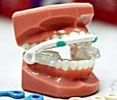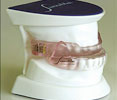 |
||
 |
Snoring, Obstructive Sleep Apnea and Oral Appliance Therapy
As a member of the American Academy of Dental Sleep Medicine, Dr. Mika has completed advanced training with the nation's leading clinicians in the treatment of snoring and Obstructive Sleep Apnea(OSA). What causes snoring and obstructive sleep apnea? Snoring occurs when the soft tissue structures of the upper airway collapse onto themselves and vibrate against each other as we move air through them. Large tonsils, a long soft palate, a large tongue, the uvula and excess fat deposits in the throat all contribute to airway narrowing and snoring. Obstructive sleep apnea occurs when the tongue and soft palate completely collapse onto the back of the throat, blocking the airway and causing airflow to stop. As the brain senses an inadequate amount of oxygen, it moves out of deep sleep and the individual partially awakens. Muscle tone in the airway then increases and the airway opens. As airflow resumes, the individual falls back into deep sleep. The airway muscles collapse and airflow stops. This scenario may repeat itself many times during the night. Why should I be concerned with snoring and OSA? Although snoring can be harmless, it can be a sign of OSA and is a cause of loss of sleep to the snorer's bed partner. The combination of low oxygen levels and fragmented sleep contribute to the symptoms a sleep apnea patient suffers. OSA patients are much more likely to suffer from cardiovascular problems such as heart attack, hypertension and congestive heart failure. OSA has been associated with strokes, morning headaches, depression and impotence. The incidence of work-related and driving accidents is also much higher in sleep apnea patients.How do I know if I have OSA? Finding your score on the Epworth Sleepiness Scale will help determine if you may have a sleep apnea problem. However, diagnosis can only be made by a physician based on the results of a patient evaluation and an overnight sleep study called a Polysomnogram(PSG).What are my treatment options? Snoring and OSA can be treated with a medical device known as CPAP(Continuous Positive Airway Pressure), with Oral Appliances made by Dr. Mika, with surgery or with a combination of these treatment approaches.What is Oral Appliance therapy and how does it work? Oral appliance therapy involves the selection, design, fitting and use of an oral appliance that when worn during sleep serves to maintain an unobstructed airway in the throat. The improved airflow reduces and often eliminates snoring, resulting in a more restful sleep. The appliance is similar to an orthodontic retainer or sports mouthguard. By repositioning and stabilizing the lower jaw and tongue, oral appliances prevent the collapse of the tongue and soft tissues of the throat thereby keeping the airway open during sleep.How many appointments are required for Oral Appliance therapy? The initial phase of therapy can take from several weeks to several months to complete. Dr. Mika usually requires several appointments involving examination and evaluation to determine the most appropriate appliance, to fit and adjust the appliance, and to maximize its performance. Currently, there are over 70 appliances available and approximately half have been FDA-approved for treatment of snoring and/or sleep apnea. How effective is Oral Appliance therapy? Recent studies show oral appliances to be most effective in treating snoring and mild to moderate OSA. When treating snoring alone, oral appliances are approximately 85% effective. When treating OSA, oral appliances are 65-70% effective depending on the severity of the apnea. While oral appliances are effective, they are not adequate for everyone and it is not yet possible to predict their success or failure prior to treatment.
What are the advantages of Oral Appliance therapy? Oral appliance therapy has several advantages over other forms of therapy that include:
Who is Oral Appliance therapy indicated for?
What types of Oral Appliances are available? Nearly all oral appliances for the treatment of snoring and OSA fall into one of two categories:
What do I need to know about my long-term treatment with Oral Appliance therapy? Since OSA tends to worsen over time, ongoing care, including short- and long-term follow-up is an essential step in your treatment. Follow-up care allows Dr. Mika to assess the treatment of your sleep disorder, the condition of your appliance, your physical response to your appliance, and to ensure that it is comfortable and effective. Although some oral appliances may last longer, appliances typically last from 2-5 years before being replaced.Does my insurance cover Oral Appliance therapy?
Most medical insurance companies have coverage for treatment of OSA with an oral appliance but generally do not cover treatment for snoring only. Most dental insurance companies do not cover treatment of OSA. You are encouraged to check with your medical insurance company. At Dr. Mika's office, we will be happy to give you all of the information you will need to complete your insurance forms so that you may be reimbursed for this service. |
||||||||||
| Joseph A. Mika, DDS, FAGD • (330) 702-6000
3700 Stutz Dr, Ste 3 • Canfield, OH 44406
1431058
|








